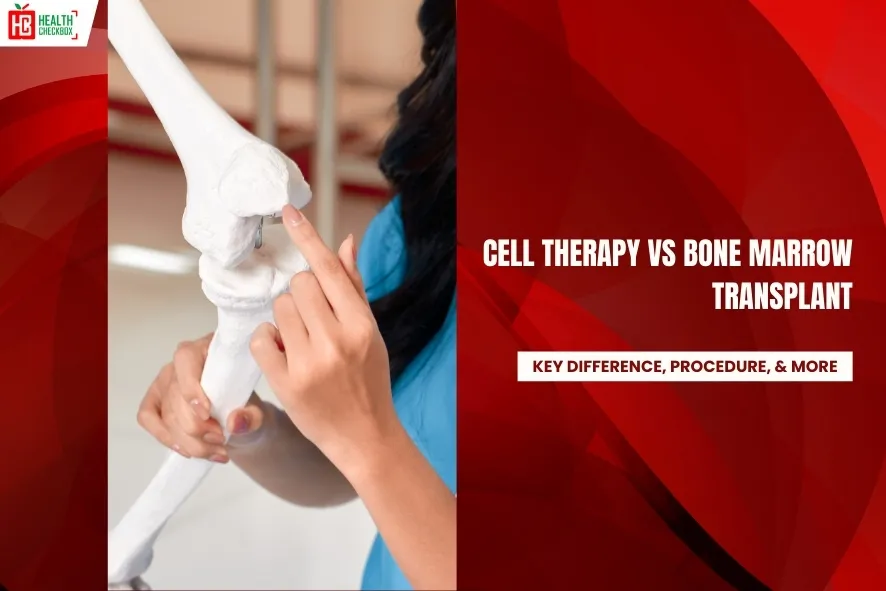Cell therapy and bone marrow transplant (BMT) are common treatments that help to treat diseased or damaged cells by transferring healthy new cells. Both are used to treat various diseases in the human body, mainly those who have blood disorders like leukemia, lymphoma, and other types of cancer. Many people are confused about cell therapy vs bone marrow transplant. They think both are the same, but they are different treatments with different purposes.
So, in this blog, we covered all the important factors of cell therapy vs bone marrow transplant, which will help you gain a better understanding of the differences. Also, we define their benefits, risks, and costs in India.
What is Cell Therapy?
Cell therapy is the transplantation of human cells in which a surgeon uses new cells to repair or restore damaged tissue to treat multiple diseases in the body. These new healthy cells are generated from the patient themselves, it may be from the donor body, or may sometimes be generated from the lab. This cell therapy can work in the human body to heal itself and enhance or boost the immune system. Also, this therapy can save the lives of cancer patients.
What is a Bone Marrow Transplant?
A bone marrow transplant (BMT) is a type of cell-replacing treatment in which doctors transplant the damaged or diseased bone marrow into healthy bone marrow. These new bone marrow cells help in increasing the body’s ability to produce healthy blood cells such as red blood cells, white blood cells, and platelets. Life after a bone marrow transplant is normal and effective. Patients who undergo this treatment can live up to 25 years more.
Key Differences: Cell Therapy vs Bone Marrow Transplant
Here, we differentiate the cell therapy and bone marrow transplant based on different conditions:
| Aspects | Cell Therapy | Bone Marrow Transplant |
| Define | Replacing damaged cells with new ones to repair damaged tissue. | Transplant the damaged or diseased bone marrow cells with the new bone marrow. |
| Purpose | To help heal itself, replace damaged tissue, or treat disease. | Increase the human body’s ability to produce healthy blood cells itself. |
| Source | It can come from the patient’s own body, from the donor, or can be made in the lab. | These cells can also come from the patient’s body, a matched donor body, or umbilical cord blood. |
| Condition Treated | It can be treated like cancers, immune disorders, injuries, or organ damage. | It treats blood cancers like leukemia and lymphoma, and bone marrow failure. |
| Recovery time | Its recovery time depends on the disease and the type of cells used. | Usually, this transplant takes a longer time, because the human body needs time to make new blood cells. |
| Risk | May cause mild or serious side effects, like the body reacting to the new cells. | Higher risk of serious problems like infection or the body rejecting the new cells. |
Benefits: Cell Therapy and Bone Marrow Transplant
Look once at the advantages of cell therapy and bone marrow transplant:
Benefits of Cell Therapy
- It helps the body heal itself.
- Cell therapy can treat serious diseases like heart disease, diabetes, cancer, and more.
- When the cell therapy uses the patient’s own body cells to repair damaged tissue, then the risk of rejection is less.
- Some types of cell therapy are used to repair skin cells and ortho injuries, like stem cells.
- It can boost the immune system and increase the ability to fight and kill leukemia cells.
Benefits of Bone Marrow Transplant
- It helps to treat blood diseases like leukemia and anemia.
- This transplant increases the strength of the immune system by providing new white blood cells.
- It helps people to live longer when other treatments do not work.
- This can help the body make good blood cells to fight or treat infection and stay healthy.
- It offers hope for genetic diseases affecting blood cells.
Risks and Complications: Cell Therapy and Bone Marrow Transplant
Here are some risk factors that can occur in both surgeries:
Risks and Challenges of Cell Therapy
- The treatment can make the immune system sometimes overreact, which may result in a high fever and low blood pressure, or even organ problems.
- In some cases, the disease may come back if the treatment does not work properly.
- Cell therapy is a very expensive treatment, and is not available in all hospitals.
- After this transplant, some patients feel irritated and confused while they are talking to someone.
- Sometimes the immune system starts harming healthy parts of the body by mistake.
Risks and Challenges of Bone Marrow Transplant
- In some cases, the body may reject the donor’s cells for some reasons.
- When donor transplants are performed, sometimes the new immune cells can attack the patient’s body, a situation called graft versus host disease (GVHD).
- After the BMT, the patient’s immune system becomes very weak, which increases the risk of high infection.
- Sometimes the new bone marrow cells do not work, and this situation is called graft failure.
- The bone marrow transplant is a very expensive treatment, and not everyone can afford it. Also, some of the hospitals cannot offer this treatment and procedure.
Conditions Treated by Cell Therapy vs Bone Marrow Transplant
Both are distinct treatments or procedures that are used in treating various medical conditions. They both use new cells to help treat disease, but they are used for different conditions and have different ways of working.
Conditions Treated by Cell Therapy
- Certain types of cancer (like leukemia and lymphoma)
- Autoimmune diseases
- Blood disorders
- Tissue damage
- Some brain diseases (like Parkinson’s disease)
- Chronic wounds
Conditions Treated by Bone Marrow Transplant:
- Blood cancer
- Blood disorders (Bone marrow failure, Sickle cell disease, and Inherited blood disorder)
- Certain genetic diseases that affect the blood or immune system
- Some severe autoimmune diseases
- Sometimes used for certain solid tumors after chemotherapy
Cost Differences between Cell Therapy and Bone Marrow Transplant in India
When we compare cell therapy and bone marrow transplant in India, both cost plays a significant role in treatment decisions.
Cost of Cell Therapy in India
Cell therapy is a cell repair or replacement treatment, which is generally expensive in India. This treatment is less widely available in Indian hospitals, only a few hospitals can offer this procedure. The cost of a cell therapy depends on the type of cell therapy performed, Stem cell therapy or Cart-T cell therapy. Stem cell therapy costs lie between ₹3 Lakh to ₹44 Lakh, and CAR-T cell therapy costs lie between ₹35 Lakh to ₹50 Lakh. It all depends on the patient’s condition, hospitals, medical facilities, and recovery time.
Cost of Bone Marrow Transplant in India
A bone marrow transplant process is a type of damaged cell replacement, the cost of which is generally higher than that of other treatments. This transplant is also less widely available in the Indian Hospital. The cost of a bone marrow transplant (BMT) lies between ₹15 lakhs to ₹35 lakhs. All costs depend on the transplant procedure, hospital facility, and stay charges, and also depend on the donor cost.
Conclusion
In this blog, we discussed cell therapy vs bone marrow transplant factors, which help you to differentiate between the treatments. I hope these key factors provide you with helpful information and knowledge. Both are best for curing health problems related to cell diseases.

